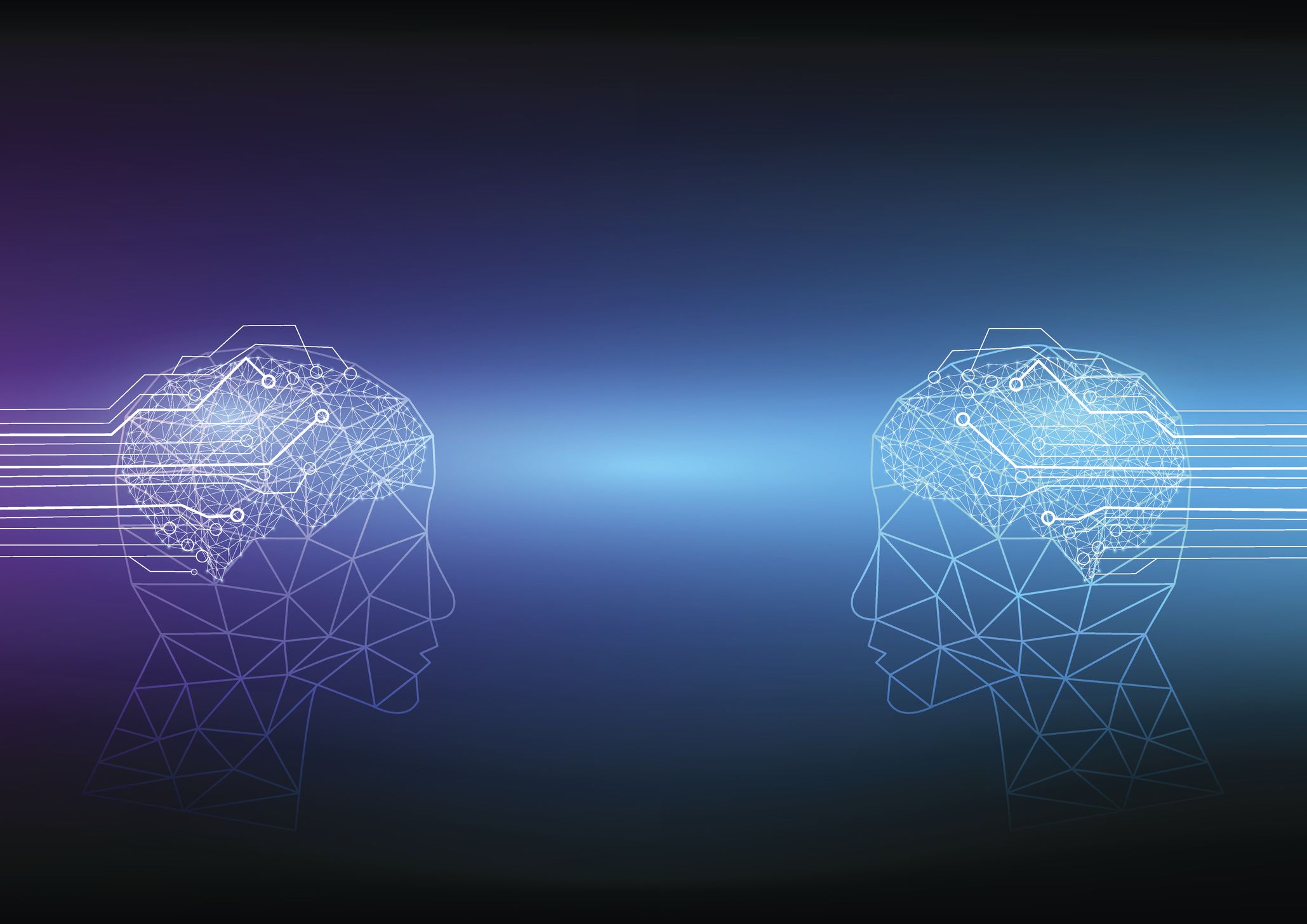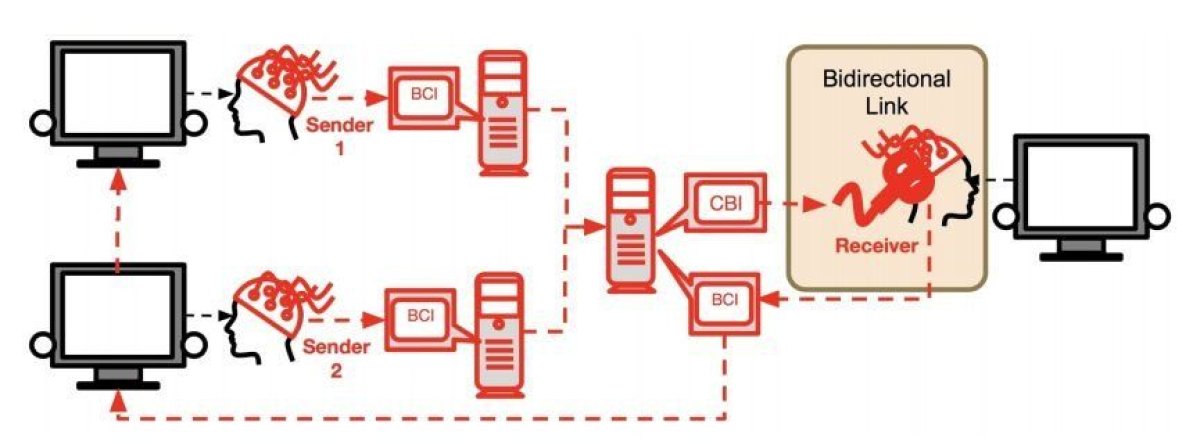
Sending your thoughts directly into someone else's brain may seem like the stuff of science fiction. But this capability could be closer to reality than you think.
A team from the University of Washington (UW) and Carnegie Mellon University has developed a system, known as BrainNet, which allows three people to communicate with one another using only the power of the brain, according to a paper published on the pre-print server arXiv.
In previous work, the team had demonstrated a system that allowed two people to communicate via brainwaves to play a video game, in what was the first human direct brain-brain interface (BBI)—technology that can both extract and deliver information to and from brains. In the latest study, the team took this idea, and added an extra person.
"In 2013, we demonstrated the first brain-to-brain interface for direct communication and collaboration between two human brains," Rajesh Rao, an author of the study from UW, told Newsweek. "The question that remained unanswered was whether one could create a 'social network' of more than two brains collaborating to solve task that none of the individual brains could. BrainNet is the first proof-of-concept demonstration of this idea."
In the experiments, two participants (the senders) were fitted with electrodes on the scalp to detect and record their own brainwaves—patterns of electrical activity in the brain—using a method known as electroencephalography (EEG). The third participant (the receiver) was fitted with electrodes which enabled them to receive and read brainwaves from the two senders via a technique called transcranial magnetic stimulation (TMS).
The trio were asked to collaborate using brain-to-brain interactions to solve a task that each of them individually would not be able to complete. The task involved a simplified Tetris-style game in which the players had to decide whether or not to rotate a shape by 180 degrees in order to correctly fill a gap in a line at the bottom of the computer screen.

All of the participants watched the game, although the receiver was in charge of executing the action. The catch is that the receiver was not able to see the bottom half of their screen, so they had to rely on information sent by the two senders using only their minds in order to play.
"The system allows the senders to observe the complete game screen and decide whether the piece needs to be rotated," Rao said. "Each sender then conveys using EEG a decision to the receiver. This decision is delivered via magnetic stimulation to the receiver's visual cortex when the decision is 'rotate,' causing [them] to experience a flash of light called a phosphene."
"Based on the information received from the two senders, the receiver acts to rotate the piece or not using EEG," he said. "The updated game screen is then displayed to the senders for a second (final) round of decision making, allow the users to potentially correct a mistake made in the first round."
This system is the first successful demonstration of a "multi-person, non-invasive, direct, brain-to-brain interaction for solving a task," according to the researchers. There is no reason, they argue, that BrainNet could not be expanded to include as many people as desired, opening up a raft of possibilities for the future.
"Brain-to-brain interfaces have the potential to transform the way humans communicate and collaborate with each other," Rao said. "They also have the potential to shed new light on how the human brain works and help restore function in people with neurological conditions."
Mark Milstein, an associate professor of Neurology and Medicine at the Montefiore Medical Center, who was not involved in the study, also noted the potential of the BrainNet system in comments provided to Newsweek.
"This study represents a fascinating new frontier in human to computer interfaces as well as non-verbal human to human communication," he said. "[It] is the first study to show that information can be transmitted and received by the brain without verbal or motor assistance."
He thinks there could be a variety of uses for the system if it continues to become more sophisticated. For example, it could help patients who are unable to speak due to brain injury—or other medical conditions—to communicate with doctors, family and friends.
"If this system advances to become wireless, one could imagine it being useful to patients who are disabled or bedbound, allowing them to answer the phone, operate a computer, or even call 911 in case of unexpected emergency," he said. "If the interface develops to the point of complex sentence transmission, this system could even be used for non-verbal communication between two humans, mimicking telepathy or mind-reading."
Ralf Schmaelzle, from the Neuroscience of Message's Lab at Michigan State University, who was not involved in the study, described the latest work as "very interesting" and said it was "exciting" to see the domains of social interaction and neuroscience, which have historically been rather separated, grow closer together.
"This is really a creative study that combines ideas and methods from different fields to create something new," Schmaelzle told Newsweek. "One body of work [it] builds on is so-called brain-computer-interfaces, or BCIs. Traditionally, many BCI applications have been very medical, for example, helping people with ALS who lose control of their muscle strength to use their brainwaves to select letters in order to communicate with other people. But it was always only one person who wore the EEG and communicated through it."

"Here we see a distinctly more 'social' application, namely that we have multiple BCIs plugged together into a 'social network' of people who don't see each other," he said. "This is really an interesting development that carries BCI to the next level."
For James Giordano, a neuroscientist and neuroethicist at Georgetown University Medical Center, the system could even open up another tantalizing possibility.
"This could represent a new form of inter-individual social communication, which could be applied in a variety of occupational and lifestyle settings," he told Newsweek. "And if we were to expand the perspective just a bit, it might also be possible to enable a more advanced form of direct communication of thought and emotion between humans and non-human animals."
Nevertheless, it is important to remember that brain-brain interfaces are currently very limited and there is still some way to go before BrainNet, or similar systems, could be used in any practical applications.
"To be clear, the capacity of this new communication channels is very low—you cannot have a normal conversation through it yet," Schmaelzle said. "All that is possible right now is sending binary information, such as whether you want to turn a Tetris-block left or right. But once the 'brain-reading' can be improved, and the 'brain-talking' can become more nuanced, this could possibly lead to new ways of silent information sharing between different minds. For now, this is science fiction."
"With sufficient advances," the authors of the latest study wrote, "one could imagine 'social networks' of connected brains in the future producing innovative and creative solutions to humanity's most important scientific and societal problems, all within a socially and ethically responsible framework."
This article has been updated to include additional comments from Mark Milstein and James Giordano.
Uncommon Knowledge
Newsweek is committed to challenging conventional wisdom and finding connections in the search for common ground.
Newsweek is committed to challenging conventional wisdom and finding connections in the search for common ground.
About the writer
Aristos is a Newsweek science reporter with the London, U.K., bureau. He reports on science and health topics, including; animal, ... Read more
To read how Newsweek uses AI as a newsroom tool, Click here.








